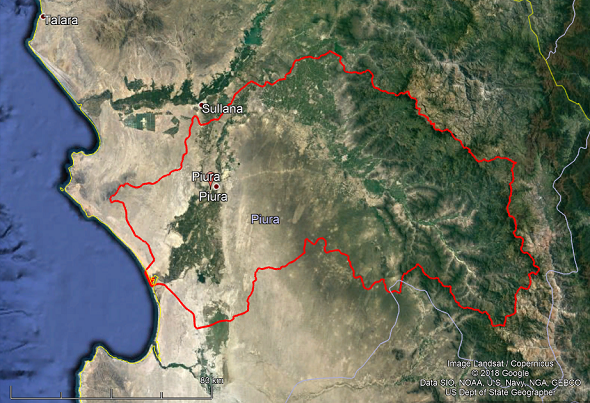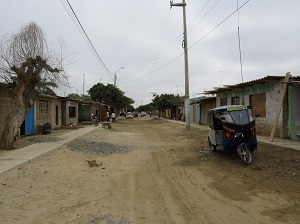
September 14, 2018, by Blue-Green team
Human-Environment Interactions and the El Niño Costero floods in Piura, Northern Peru
In this blog, Leon Kapetas discusses flooding, vulnerability and risk management in Piura, Peru.
When Piura’s civil protection team asked residents to evacuate their villages in Piura’s river floodplain, they hesitated to leave. They knew that a flood was going to arrive soon and put themselves and their properties at risk, but they also knew that this was an opportunity for theft. This is not the first thing that most of us would think of. It is this socio-cultural context that made these people vulnerable to flooding, not the lack of information as the flood was unfolding.
Workshop: Building resilience in flood disaster management in Northern Peru
This example illustrates the vital importance of local context when discussing flood resilience. This was the focus of the workshop “Building resilience in flood disaster management in Northern Peru”: talking to local experts and residents to learn from their experiences. It is obvious that what works in the UK would not necessarily work in Peru, so only after listening carefully we can start thinking of solutions.
In this week-long event held in Piura City, a delegation of scientists from the UK worked closely with scientists, policy-makers and decision-makers from Peru to examine what went wrong during the 2017 floods and what can be done so this does not happen again.
Background information: 2017 floods and El Niño
Piura River flows through the centre of Piura city (with a population of about 400,000) and nearby settlements and towns, such as Catacaos, which were also severely affected during the March 2017 flood. It was not just Piura that flooded during the 2017 El Niño; other regions were also affected resulting in more than 90 deaths and vast economic damage up to $9bn for the country.
Before visiting I had done a bit of research and felt I knew the full story. In non-scientific terms, the El Niño Costero (the El Niño of the coast), which is a temperature anomaly in the South-tropics Eastern Pacific Ocean, led to increased evaporation, followed by condensation and extreme precipitation in the Andean-coastal zone. This inevitably led to high river flows, so extreme that the rivers eventually overflowed and caused catastrophic flooding.

MAP: Piura catchment stretches from the Andes to the coast. Piura city lies in the mid-low section, upstream of the formed irrigation land. The coastal zone is a desert, normally receiving very little rain.
Though this story is quite simple and accurate, while talking to local experts I slowly started understanding the underlying complexity. Why did this occur in this specific catchment? Why was the disaster so devastating? There are no straightforward answers to give, but there are significant human-environment interactions that have contributed to this disaster and need to be understood.
Human-environment interactions
The upstream part of the catchment has been partially deforested reducing infiltration and accelerating sediment transport. The river section at Piura Centre is channelised. The downstream part of the catchment is heavily engineered. Artificial embankments (with the help of a canal system) built over the last 30 to 40 years have reclaimed large parts of the floodplain to create fertile land in the middle of the desert. This approach works during non-flood conditions, but has led to increasing risk during high-precipitation events.
As a result of the engineering work, the river is disconnected from the sea reducing its conveyance capacity (the river now drains to a lagoon on the southwest boundary of the catchment). Over the years, sediments were trapped in the middle (Piura City) and downstream sections. About 80% of the gradient between the city and the discharge point has been lost due to sedimentation. This means that there is less room for water within the river’s cross-section (remember also the flood-plain has been reclaimed!), and there is less gradient to convey the flow. Constraining the river within the embankments allowed settlements (inhabited mostly by subsistence farmers) to develop in the reclaimed agricultural land and the town of Catacaos to grow further.
Risk = Exposure + Vulnerability + Shock
These three factors combined created a ticking time bomb for the next El Niño (the “shock”). Population growth within the floodplain increased exposure. Communities were vulnerable as they were not well prepared due to reduced financial ability. Perhaps risk underestimation contributed to unpreparedness as El Niño does not take place that frequently. But also, as mentioned in the beginning, they could not leave their homes unprotected.
It helps to think in fundamental terms, e.g. using this definition of risk, to inform better policies and practices. There are, therefore, vital questions that we need to answer:
- Are there spatial planning policies that can help reduce flood risk? Limiting informal settlements can reduce exposure. However, subsidence farmer’s livelihoods are bound to their land. Therefore, more comprehensive policies would be required if they would have to relocate (see photos of relocation settlement below).
- Engineering can solve one problem but unintentionally create another. In hard engineering solutions such as dams and embankments, sediment transport processes are as important as flow conveyance/control. No further engineering should be carried out without a solid evidence base.
- Solutions need to include communities. Soft and hard interventions should allow communities not only to reduce physical but also social vulnerability. Dealing with only flooding is not enough if one considers that these communities do not have water supply. Turning water infrastructure from a risk reduction measure into a development tool is a good opportunity that also justifies investment.
I would like to thank Roger Wall and David Proverbs from Birmingham City University for the invitation and organisation of the workshop. The work was supported by a Research Links grant under the Newton-Paulet Fund partnership. This grant was funded by the UK Department of Business, Energy and Industrial Strategy (BEIS) and the Peruvian National Council of Science, Technology and Technological Innovation (CONCYTEC) and delivered by the British Council.
Read more about Leon‘s work on the Urban Flood Resilience project in WP1. Resilience and WP2. Resource.
No comments yet, fill out a comment to be the first





Leave a Reply